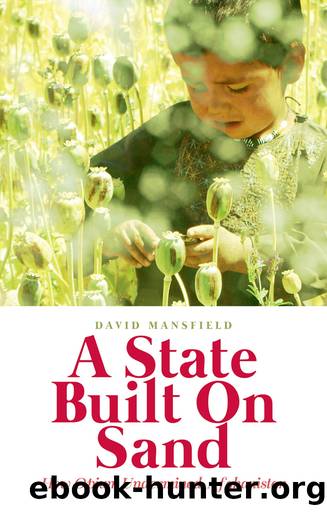A State Built on Sand by Mansfield David;

Author:Mansfield, David;
Language: eng
Format: epub
Publisher: Oxford University Press, Incorporated
Published: 2016-10-15T00:00:00+00:00
Conclusion
By spring of 2013, much of Nangarhar was in disarray. Most notably, the insurgency had gained a firm foothold within the province. No longer hemmed in along the Pakistani border, the insurgency could be found throughout Sherzad and Hesarak, the Shinwari tribal areas, and in the lower districts of Chapahar and Bati Kot. There were also signs of a growing insurgent presence in the main Kabul River valley along the Jalalabad to Torkham road.
At the political centre of Nangarhar, there was growing conflict as a result of the breakdown in the political settlement between the provincial ruling elite, Governor Shirzai and different political factions in Kabul. Disputes over rent extraction, the distribution of government positions and patronage, as well as personal acrimony, had led to the regrouping of old jihadi alliances and the formation of new political coalitions in opposition to Shirzai. The contest for control over state institutions in the province became intense with the resurgence of prominent former jihadi commanders and their families following their election to national and provincial representative bodies in 2009 and 2010. The withdrawal of US forces, the closure of the PRT in April 2013 and the presidential elections in 2014âwith uncertainty over how the potential candidates and their respective networks would alignâfurther fractured the body politic.
It would be wrong, however, to assume that political order in Nangarhar was determined solely by the manoeuvrings of the provincial political and military elite, many of whom have had their control over state power wrested from them on many occasions over the last two decades. In part, these provincial leaders derived their power from the local elite and the rural population that they claimed to represent, and from the political and military support these communities could provide. Events in the rural districts of Nangarhar, given the significance of the provincial economy, also had a significant influence on the dynamics of power sharing and rent distribution in Kabul. As Coburn notes (2013: 2), in Afghanistan ânational figures have for a good part remained relevant because they continue to convince enough local leaders at the district level that it is in their best interests to support themâ.
Opium production and efforts to control it were also an essential element in the dynamics of Nangarhari politics. Over the last two decades, opium production and counternarcotics policies have played pivotal roles in the bargains between the rural population, local elites and those vying for power in Jalalabad. Cultivation and efforts to control it have shaped political relations and patronage with the political centre in Kabul, as well as with the international communityâmost notably the USGâin Washington, DC, Kabul and within the province itself.
As with the previous opium ban, enforced in the 2004/5 growing season, the province-wide prohibition imposed by Governor Shirzai in 2007 had largely unravelled by spring 2013. This ban, which drew considerable praise from the international community in 2008 when the province was declared âpoppy freeâ, had shown signs of stress since the 2009/10 growing season. The resurgence in opium
Download
This site does not store any files on its server. We only index and link to content provided by other sites. Please contact the content providers to delete copyright contents if any and email us, we'll remove relevant links or contents immediately.
International Integration of the Brazilian Economy by Elias C. Grivoyannis(57277)
The Radium Girls by Kate Moore(10901)
Turbulence by E. J. Noyes(7031)
Nudge - Improving Decisions about Health, Wealth, and Happiness by Thaler Sunstein(6629)
The Black Swan by Nassim Nicholas Taleb(6182)
Pioneering Portfolio Management by David F. Swensen(5599)
Rich Dad Poor Dad by Robert T. Kiyosaki(5140)
Zero to One by Peter Thiel(4816)
Man-made Catastrophes and Risk Information Concealment by Dmitry Chernov & Didier Sornette(4728)
Secrecy World by Jake Bernstein(3773)
Millionaire: The Philanderer, Gambler, and Duelist Who Invented Modern Finance by Janet Gleeson(3565)
Skin in the Game by Nassim Nicholas Taleb(3455)
The Age of Surveillance Capitalism by Shoshana Zuboff(3411)
The Money Culture by Michael Lewis(3276)
Skin in the Game: Hidden Asymmetries in Daily Life by Nassim Nicholas Taleb(3259)
Bullshit Jobs by David Graeber(3171)
The Dhandho Investor by Mohnish Pabrai(3161)
The Wisdom of Finance by Mihir Desai(3069)
Blockchain Basics by Daniel Drescher(2883)
